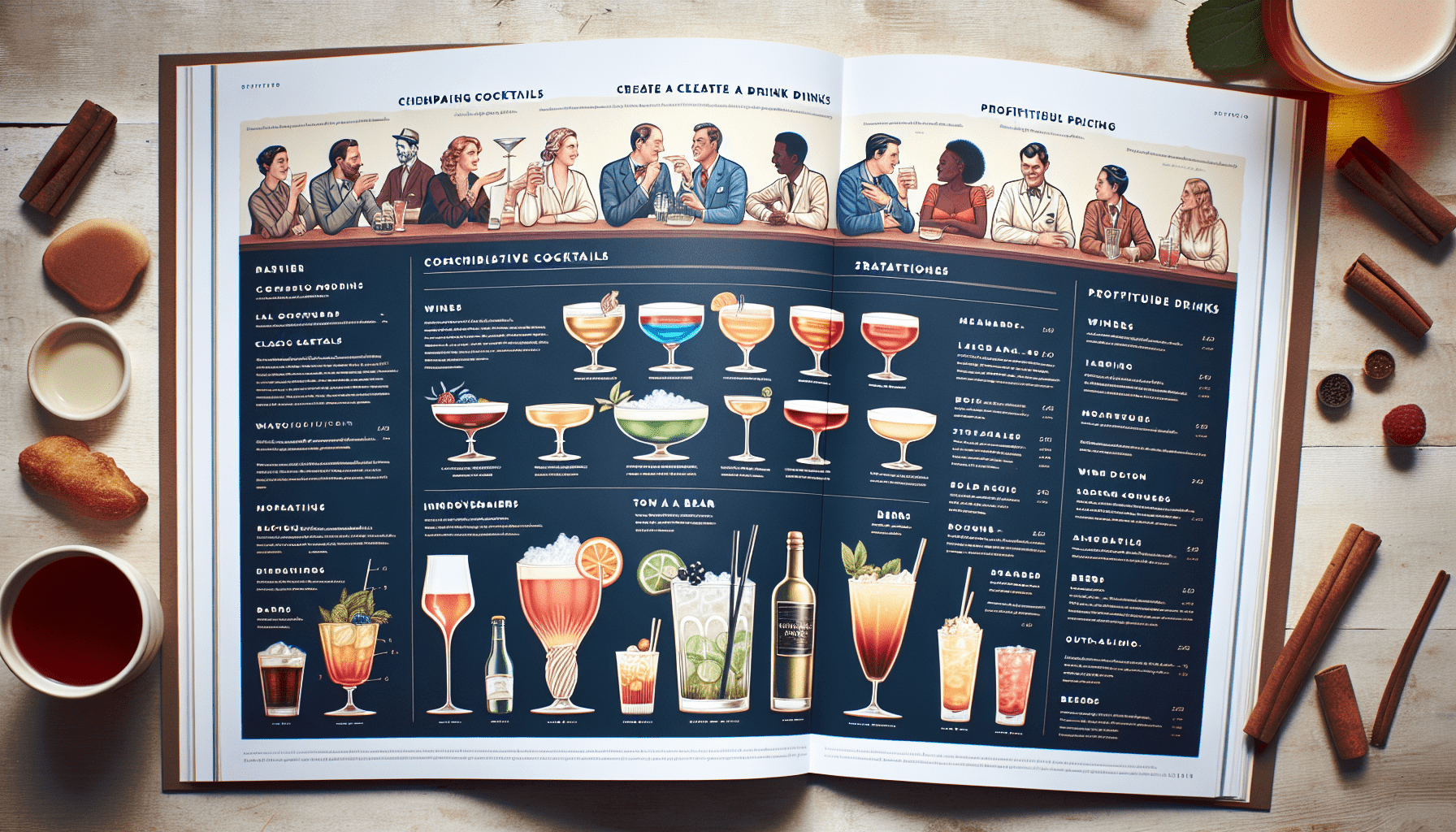Are you a bar owner or manager looking to create a drink menu that not only appeals to a wide range of tastes but also boosts your profitability? Look no further! In this article, you will discover some expert tips and tricks on how to build a diverse and profitable drink menu for your establishment. From incorporating trendy and innovative cocktails to offering a variety of alcoholic and non-alcoholic options, we’ve got you covered. Get ready to attract new customers, keep them coming back for more, and maximize your bar’s revenue potential.
Understanding Your Target Audience
Identifying the demographics of your target audience
Understanding the demographics of your target audience is crucial when creating a diverse and profitable drink menu for a bar. By identifying key demographic factors such as age, gender, location, and income level, you can tailor your menu to cater to their preferences and taste. For example, if your target audience is predominantly young professionals in the city, you may want to include a selection of trendy cocktails and craft beers. On the other hand, if your bar is located in a family-friendly neighborhood, offering a range of non-alcoholic mocktails and wholesome drink options would be more suitable.
Conducting market research to understand customer preferences
Market research plays a vital role in understanding customer preferences and trends. It helps you gather insights into what your target audience is currently enjoying and what they might be looking for in a bar menu. Conduct surveys, focus groups, and interviews to gather data on preferred drink types, flavors, and even the overall ambiance they seek in a bar. This information will guide you in curating a menu that appeals to your target audience and keeps them coming back for more.
Analyzing customer feedback and suggestions
Listening to your customers is key to continuously improving and refining your drink menu. Encourage feedback through comment cards, online reviews, or even direct conversations with your patrons. By carefully analyzing this feedback, you can identify popular drinks, uncover any areas for improvement, and make necessary adjustments. Your customers ultimately hold the power to shape your menu based on their preferences and suggestions, so make sure to value their opinions and bring their ideas to life.
Incorporating popular drink trends into the menu
Staying up-to-date with the latest drink trends is essential for keeping your menu fresh and appealing to your target audience. Pay attention to popular ingredients, innovative techniques, and emerging styles of drinks that are gaining traction in the industry. Whether it’s a new type of craft beer, a unique cocktail garnish, or an on-trend flavor combination, incorporating these trends into your menu can give your bar a reputation for being trendy and forward-thinking. Remember to strike a balance between timeless classics and exciting new options to cater to varying preferences within your target audience.
Categorizing Drinks
Creating a well-balanced mix of alcoholic and non-alcoholic options
A diverse drink menu should offer something for everyone, including those who prefer non-alcoholic beverages. While alcoholic options like beer, wine, and spirits are essential in a bar menu, incorporating a range of non-alcoholic drinks is equally important. Consider offering mocktails, fresh fruit-infused waters, and specialty sodas for those who choose to abstain from alcohol. By providing a variety of choices, you ensure that all customers feel welcome and can find something to enjoy.
Segmenting drinks by type (e.g., beer, wine, cocktails)
Organizing your drink menu by category makes it easier for customers to navigate and find their preferred beverage. Segment your menu into distinct sections such as beer, wine, and cocktails, ensuring each category is well-represented. Within each section, consider further dividing the drinks by style or flavor. For example, under the cocktail section, have subcategories like fruity cocktails, classic cocktails, and signature creations. This segmentation helps customers quickly locate their drink of choice and enhances their overall menu browsing experience.
Offering a variety of flavors within each category
Within each drink category, providing a variety of flavors is essential to cater to different preferences. Ensure that your beer selection includes a range of flavors, from light and refreshing to rich and bold. Similarly, offer a diverse range of wine options, including different varietals like red, white, and rosé, as well as variations in sweetness and body. When it comes to cocktails, create a menu that encompasses both familiar classics and unique flavor combinations, appealing to customers with varying tastes. By offering a wide flavor spectrum within each category, you maximize the chances of customers finding their perfect drink.
Highlighting local and craft beverage options
Showcasing local and craft beverages on your menu adds a unique touch and appeals to customers who appreciate supporting local businesses. Partner with nearby breweries and wineries to feature their products prominently. Highlight the local specialties and craft brews, giving customers a sense of pride in trying something exclusive to their area. This emphasis on local and craft options not only adds variety to your menu but also helps build a connection with the community you serve.
Crafting Signature Drinks
Developing unique and exclusive drink recipes
Crafting signature drinks gives your menu a standout element that sets your bar apart from the competition. Experiment with different ingredients and flavor combinations to create unique recipes that cannot be found elsewhere. By offering exclusive drinks, you provide customers with a memorable experience they can only find at your bar, increasing their likelihood of returning. Consider incorporating local or seasonal elements into your signature drinks to further enhance their uniqueness and appeal.
Experimenting with different ingredients and flavor combinations
To continuously innovate your menu, be open to experimenting with various ingredients and flavor combinations. Mixology is an art, and by experimenting, you can discover unexpected flavor profiles and exciting new drinks. Test out different spirits, syrups, bitters, and garnishes to create intriguing flavor combinations that will impress your customers. Encourage your bartenders to get creative and offer their own suggestions for unique drinks. With a willingness to experiment, your bar can become known for its inventive and delicious concoctions.
Incorporating local or seasonal elements into signature drinks
Adding local or seasonal elements to your signature drinks not only enhances their appeal but also creates a connection with your customers and the local community. Consider using locally sourced fruits or herbs to infuse regional flavors into your drinks. For example, if your bar is located near a citrus farm, incorporate fresh citrus juices or peels into your recipes. Additionally, embrace seasonal ingredients and create limited-time specials that capture the spirit of each season. This approach keeps your menu exciting and encourages customers to visit your bar throughout the year to try the latest seasonal offerings.
Naming and branding the drinks to create a memorable experience
Naming and branding your signature drinks is essential for creating a memorable experience for your customers. Craft clever and intriguing names that align with the characteristics and flavors of the drink. Clever wordplay, references to local landmarks or culture, or even puns can make the drink names more engaging. Additionally, invest in visually appealing drink menus or table tents that showcase the drink names, descriptions, and vibrant images. Creating a cohesive and visually appealing brand around your signature drinks adds an extra layer of excitement and entices customers to try them.
Promoting Health-Conscious Options
Including low-calorie and low-sugar drink choices
In today’s health-conscious society, it is important to cater to customers who prioritize wellness, even when enjoying a drink at a bar. Include low-calorie and low-sugar drink options on your menu to accommodate these preferences. Consider offering light beers, wines with lower alcohol content, and cocktails made with fresh ingredients and natural sweeteners. Providing guilt-free drink choices ensures that health-conscious individuals can enjoy a night out without compromising their dietary goals.
Offering fresh fruit-infused cocktails and mocktails
Fresh fruit-infused cocktails and mocktails are not only visually appealing but also provide a refreshing and flavorful alternative for those seeking a healthier drink option. Incorporate a variety of fresh fruits like berries, citrus, and tropical fruits into your drink menu. Muddle or infuse the fruits with the spirits or mixers to create vibrant and aromatic beverages. For non-alcoholic options, offer a selection of fruit-infused mocktails that allow customers to enjoy the flavors without the alcohol content. These options tempt the taste buds and satisfy cravings while still maintaining a health-conscious approach.
Providing organic, gluten-free, and vegan drink alternatives
To accommodate customers with specific dietary restrictions or preferences, it is important to include organic, gluten-free, and vegan drink alternatives on your menu. Incorporate organic wines or spirits into your offerings and clearly label them as such. Ensure that the mixers and syrups used in your cocktails are gluten-free, and consider having a separate section on the menu dedicated to gluten-free options. For vegan customers, provide information on drink options that do not contain any animal-derived ingredients. By being inclusive and catering to diverse dietary needs, you create a welcoming environment for all patrons.
Educating customers about the nutritional benefits of certain beverages
Education can play a significant role in promoting health-conscious choices among your customers. Consider including short descriptions highlighting the nutritional benefits of certain beverages on your menu. For example, mention that a particular cocktail is packed with vitamin C from fresh citrus juices or that a certain beer is low in carbohydrates and calories. Sharing this information empowers customers to make informed choices and encourages them to try drinks that align with their wellness goals. By educating customers about the nutritional benefits, you position your bar as a place that values their overall well-being.
Collaborating with Local Breweries and Wineries
Forging partnerships with nearby breweries and wineries
To build a diverse and profitable drink menu, establish partnerships with nearby breweries and wineries. Local partnerships offer a range of benefits, such as access to exclusive products and special promotions. By collaborating, you showcase your support for the local community and differentiate your bar by offering unique beverages that cannot be found elsewhere. Connect with local brewers and winemakers to discuss potential collaborations and explore opportunities to showcase their offerings at your establishment.
Highlighting locally-produced beers and wines on the menu
Emphasize locally-produced beers and wines on your menu to showcase regional flavors and support local businesses. Dedicate a section of your menu to feature these local gems, providing descriptions and recommendations for each drink. Educate your staff about the unique characteristics of each beer or wine, encouraging them to share this knowledge with customers and enhance their tasting experience. By highlighting local products, you attract customers who appreciate the authenticity and distinctiveness of these beverages.
Organizing tasting events and collaborations
Organize tasting events and collaborations with local breweries and wineries to create buzz around your bar and generate customer interest. Host beer or wine pairing dinners where guests can sample a variety of drinks paired with complementary foods. Consider inviting representatives from the partnering local breweries and wineries to attend these events, providing insights, and answering questions about the beverages. These events not only provide customers with a memorable experience but also strengthen the relationships between your bar and the local beverage producers.
Supporting the local community and building loyalty
By collaborating with local breweries and wineries, you demonstrate your support for the local community. Engage in philanthropic efforts, such as donating a portion of proceeds from certain drinks to local charities or participating in community events. This involvement builds a positive image for your bar and fosters a sense of loyalty among your customers. When patrons feel a connection to your establishment and recognize your commitment to the community, they are more likely to become regulars and advocate for your business.
Considering Seasonal and Trending Drinks
Introducing seasonal drink specials to capture the spirit of different times of the year
Introducing seasonal drink specials is a fantastic way to embrace the changing seasons and capture the spirit of different times of the year. Develop a range of cocktails and beverages that incorporate seasonal ingredients or flavors. For example, offer refreshing and fruity drinks during the summer and warm and spiced options during the winter. These seasonally inspired drinks give customers a reason to visit your bar throughout the year and provide a sense of excitement about the latest offerings.
Staying up-to-date with current drink trends
To stay relevant and appealing, it’s important to stay up-to-date with current drink trends in the industry. Keep an eye on what drinks are gaining popularity, both locally and internationally. Subscribe to industry publications, follow influential bartenders and mixologists on social media, and attend industry events and workshops. By staying informed, you can ensure that your menu is always on-trend and attractive to customers seeking the latest and greatest in the drink world.
Researching and incorporating popular cocktail ingredients
Researching and incorporating popular cocktail ingredients is a great way to keep your menu fresh and exciting. Identify ingredients that are currently in high demand, such as unique botanicals, specialty liquors, or artisanal bitters. Experiment with these ingredients and create new cocktails or give a modern twist to classic recipes. By incorporating popular cocktail ingredients, you give your menu a contemporary edge and show customers that your bar is in tune with their preferences.
Offering limited-edition or themed drinks for special occasions
To add a sense of exclusivity and intrigue, offer limited-edition or themed drinks for special occasions. Create unique concoctions for holidays like Valentine’s Day, Halloween, or New Year’s Eve. Design beverages inspired by popular movies, TV shows, or cultural events that resonate with your target audience. These limited-time offerings generate excitement and encourage customers to visit your bar and try something out of the ordinary. Make sure to promote these drinks through your marketing channels to maximize their impact and attract customers.
Training and Educating Staff
Instructing employees on the entire drink menu offerings
To provide exceptional service to your customers, it is vital to instruct your staff on the entire drink menu offerings. Equip them with in-depth knowledge about each drink category, the ingredients used, and their preparation methods. This enables your staff to confidently assist customers in making informed choices and answering any questions they may have. Conduct regular training sessions to ensure that your staff remains up-to-date with any menu changes or new drink introductions.
Providing knowledge about different drink categories and flavors
Beyond the basics, provide your staff with knowledge about different drink categories and flavors. Teach them about the characteristics of various spirits, the differences between beer styles, and the nuances of different wine varietals. This knowledge allows your staff to recommend suitable options based on customer preferences and creates a personalized and attentive service experience. Encourage your bartenders and servers to engage in regular tasting sessions to develop their palate and better understand the flavor profiles of your menu offerings.
Teaching proper serving techniques and garnish presentation
Proper serving techniques and garnish presentation are essential for creating visually appealing and well-executed drinks. Train your staff on the correct preparation methods, glassware selection, and garnish placement for each drink. This attention to detail elevates the overall presentation of the beverage and enhances the customer’s perception of the drink’s quality. Teaching your staff the art of precise and aesthetically pleasing drink presentation ensures that every drink served from your bar is a work of art.
Encouraging staff to make personalized recommendations to customers
Empower your staff to make personalized recommendations to customers based on their individual preferences. Encourage them to engage in conversations with customers to understand their taste preferences, flavor profiles they enjoy, and even their mood or occasion for visiting. With this knowledge, your staff can suggest drinks that align with the customer’s preferences, creating a personalized and memorable experience. By going the extra mile to make personalized recommendations, your staff establishes rapport with customers and builds a loyal customer base.
Pricing Strategies
Setting competitive pricing based on ingredient costs and market value
Setting the right pricing for your drinks is crucial for ensuring profitability. Consider the ingredient costs, including the alcohol, mixers, and garnishes used in each drink, when determining the pricing. Take into account the market value of similar drinks in your area to ensure that your prices are competitive. While it is essential to be profitable, avoid setting prices too high that they discourage customers from ordering certain drinks. Finding the right balance between profitability and customer affordability is essential for a successful pricing strategy.
Creating tiered pricing options for various drink categories
To cater to different budgets and preferences, create tiered pricing options for various drink categories. Offer a range of options within each category, starting from more affordable choices to premium selections. This tiered pricing structure allows customers to find options that suit their preferences while accommodating varying price points. Clearly distinguish the different tiers in your menu, ensuring that customers can easily identify and select the pricing option that aligns with their budget.
Offering happy hour and daily specials to attract customers
Happy hour and daily specials are effective strategies to attract customers during specific times or days. Create enticing offers such as discounted prices, buy-one-get-one deals, or special promotions on selected drinks during specific hours. These promotions create a sense of urgency and encourage customers to visit your bar at times when it may not be as busy. By offering happy hour and daily specials, you can increase foot traffic during slower periods and build a loyal customer base that recognizes your bar as a go-to spot for great deals.
Analyzing profit margins and adjusting prices accordingly
Regularly analyze your profit margins to ensure that your pricing strategy aligns with your profitability goals. Monitor the sales data for each drink, taking into account both the popularity and profitability of each item. Identify any underperforming drinks that may need price adjustments to improve their profitability. Conversely, if certain drinks are selling exceptionally well and have higher profit margins, consider adjusting their prices to maximize revenue. By analyzing profit margins and making necessary adjustments, you can maintain a sustainable and profitable drink menu.
Designing an Appealing Menu Layout
Choosing an easy-to-read font and layout
When designing your menu, opt for an easy-to-read font and layout that enhances the overall readability. Avoid using overly decorative or elaborate fonts that may be challenging to read, especially in dimly lit bar environments. Use a font size and spacing that allows customers to navigate the menu effortlessly. Consider using clearly marked headers and subheadings for each drink category for easy menu scanning.
Creating visually appealing graphics and illustrations
Include visually appealing graphics and illustrations in your menu to enhance its overall aesthetics. Use high-quality images of selected cocktails, beers, or wines to entice customers and provide a visual representation of what they can expect. Incorporate illustrations or icons that effectively communicate the flavors or characteristics of each drink, making it easier for customers to make informed choices. The combination of well-placed images, illustrations, and icons adds a visual allure to your menu, increasing its appeal.
Organizing the menu by drink categories and subcategories
Organize your menu in a logical and intuitive flow by categorizing drinks and using subcategories. Begin with an introduction or a welcome section that sets the ambiance and tone of your bar. Follow with clearly defined drink categories such as beer, wine, and cocktails. Within each category, use subheadings or dividers to group similar drinks together, making it easier for customers to navigate the menu. This organization ensures that customers can quickly find their preferred drink and enhances their overall menu browsing experience.
Utilizing high-quality images to enhance the drink descriptions
Utilize high-quality images to enhance the drink descriptions in your menu. Visual representations of the drinks provide customers with a better understanding of the appearance and presentation style of each beverage. Pair images with concise and mouthwatering descriptions that highlight the key flavors and ingredients. The combination of enticing descriptions and appealing images creates a sensory experience for customers, increasing their desire to try the drinks.
Evaluating and Updating the Menu Regularly
Monitoring sales and customer feedback
Regularly monitor the sales data of each drink to evaluate their popularity and profitability. Analyze which drinks are selling well and contributing to your bar’s revenue. Additionally, take note of customer feedback and comments regarding the menu offerings. Observe which drinks receive positive feedback and recommendations, as well as any recurring complaints or suggestions. By closely monitoring sales and customer feedback, you can identify opportunities for improvement and gauge the success of your menu items.
Identifying popular and underperforming drink options
Based on sales data and customer feedback, identify popular and underperforming drink options in your menu. Pay attention to the drinks that consistently generate high sales and positive feedback from customers. These are the items that you can consider keeping as menu staples or feature as signature drinks. Similarly, identify the drinks that do not sell well or receive lukewarm reviews. Evaluate whether they need recipe revisions, repositioning, or removal from the menu altogether. This analysis helps you continuously refine your menu offerings and maintain a profitable selection.
Refreshing the menu with new and innovative beverages
To keep your menu exciting and enticing, regularly refresh it with new and innovative beverages. Consider introducing new recipes or drinks that align with current trends or provide a unique twist. Experiment with seasonal ingredients, limited-edition creations, or collaborative drinks with local breweries and wineries. Refreshing the menu not only entices customers to try something new but also encourages their return to explore upcoming offerings. Regularly rotating and introducing new beverages keeps your menu vibrant and ensures that customers always have something to look forward to.
Removing items that are not selling well or outdated
Just as important as introducing new items is removing items that are not selling well or have become outdated. Continuously evaluate the performance of each drink and identify any that consistently underperform. Assess whether these items can be revised or removed to make room for more popular and profitable choices. Additionally, consider removing drinks that no longer align with current trends or customer preferences. By regularly reviewing and updating your menu, you maintain a focused and appealing selection that resonates with your target audience.




